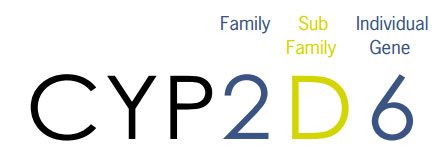In this article 
View / Download
pdf version of this article
Relevance in the treatment of depression
Imagine: one of your patients is newly diagnosed with depression but before prescribing
medication you perform a simple blood test in the surgery to predict which drug will have the best chance of therapeutic
effect with minimal adverse effects. Furthermore you can also do this for a whole range of drugs and diseases including
hypertension and epilepsy. A dream perhaps, but the first step towards reality has already been made. In January 2005
the FDA approved AmpliChip CYP450 the first widely available pharmacogenetic test.
First it might be helpful to provide an overview of the cytochrome P450 (CYP450) enzyme system which is responsible
for metabolising most drugs.
The CYP450 System
Many drugs are metabolised by the CYP450 enzymes in the liver. The end result is either inactive compounds that can
be excreted, or active compounds which can be further metabolised leading to eventual removal from the body. The CYP450
system consists of many enzyme subtypes each metabolising a specific range of drugs (substrates).

Some of the enzymes (e.g. CYP2D6 and CYP2C19) exhibit genetic polymorphisms and the frequency of these polymorphisms
varies between ethnic groups. These genetic differences mean some people have an enzyme with reduced or no activity. In
the case of CYP2D6 there are at least 3 variants giving phenotypes who are poor metabolisers, extensive metabolisers (the
majority of people) or ultra fast metabolisers.
People who are poor metabolisers may have an increased risk of adverse reactions to a drug metabolised by the affected
enzyme or reduced capability to convert a parent drug in to the active drug. As an example of genetic variation, the frequency
of CYP2D6 poor metabolisers is 5 - 10 % in Caucasians and 1% in East Asians.
Some CYPs (CYP3A4) can have their activity increased (induced) by other drugs leading to increased substrate metabolism.
Conversely some drugs can block (inhibit) the activity of a CYP enzyme and reduce substrate metabolism.
Examples:
- Fluoxetine is a substrate for CYP2D6 and a potent inhibitor of this enzyme. TCAs such as amitriptyline are also metabolised
by CYP2D6. Fluoxetine will inhibit this and increase plasma concentrations of the TCA and increase dose related adverse
effects.
- The activity of codeine is mainly due to conversion to morphine by CYP2D6. A poor metaboliser for this enzyme will
have poor analgesic response due to lack of conversion. A drug which is an inhibitor of CYP2D6 (e.g. paroxetine) will,
in effect, change a normal metaboliser to a poor metaboliser.
- A CYP2D6 poor metaboliser will have reduced capacity to metabolise some antidepressants (e.g. fluoxetine, paroxetine
and amitriptyline) and be more sensitive to dose related adverse effects.
- Theophylline is a substrate for CYP3A4. Phenytoin induces CYP3A4 which increases the metabolism of theophylline and
reduces plasma concentrations.
Many antidepressant and psychoactive drugs are metabolised by CYP2D6, and to a lesser extent, CYP2C19 which exhibit
genetic polymorphism (see Table 1).
Table 1. Main metabolic pathways of commonly prescribed antidepressants
| Drug |
Main Metabolising enzyme |
Notes |
| Fluoxetine |
CYP2D6 Some other CYPS involved |
Potent inhibitor of CYP2D6
Active metabolite (norfluoxetine) inhibits CYP3A4 |
| Paroxetine |
CYP2D6 |
Potent inhibitor of CYP2D6 |
| Citalopram |
CYP2C19 CYP2D6 only partly involved. |
Only inhibits CYP2D6 very weakly |
| Venlafaxine |
CYP2D6 |
CYP2D6 inhibitors taken at same time will increase plasma concentrations of venlafaxine.
Active metabolite is metabolised by CYP3A4 |
| Most TCA�s (e.g. amitriptyline) |
CYP2D6 Some other CYPs involved |
CYP2D6 inhibitors taken at same time will increase plasma concentrations of TCA. |
In general CYP2D6 poor metabolisers are likely to have poor tolerance to TCAs, venlafaxine and the SSRIs paroxetine
or fluoxetine. A smaller dose may be required for therapeutic effect and to minimize adverse effects. Citalopram may be
better tolerated by CYP2D6 poor metabolisers. Conversely, CYP2C19 poor metabolisers are likely to have poor tolerance
of some TCAs and possibly citalopram.
The science has a long way to go before we can truly predict response from CYP
genotyping but the potential is obvious.
There is also still some way to go before the true clinical relevance and justification for this test are known and
there is currently minimal evidence for using it in clinical practice.
Related reading and resources
De Leon J, Armstrong S, Cozza K. Clinical guidelines for psychiatrists for the use of pharmacogenetic testing for CYP4502D6
and CYP4502C19. Psychosomatics 2006;47:75-85.
Drug Interactions; Defining genetic difference on pharmacologic responses. Available from;
http://medicine.iupui.edu/flockhart/
Martin J, Fay M. Cytochrome P450 drug interactions: are they clinically relevant? Aust Prescr 2001;24:10-2. Available
from; http://www.australianprescriber.com/magazine/24/1/10/2